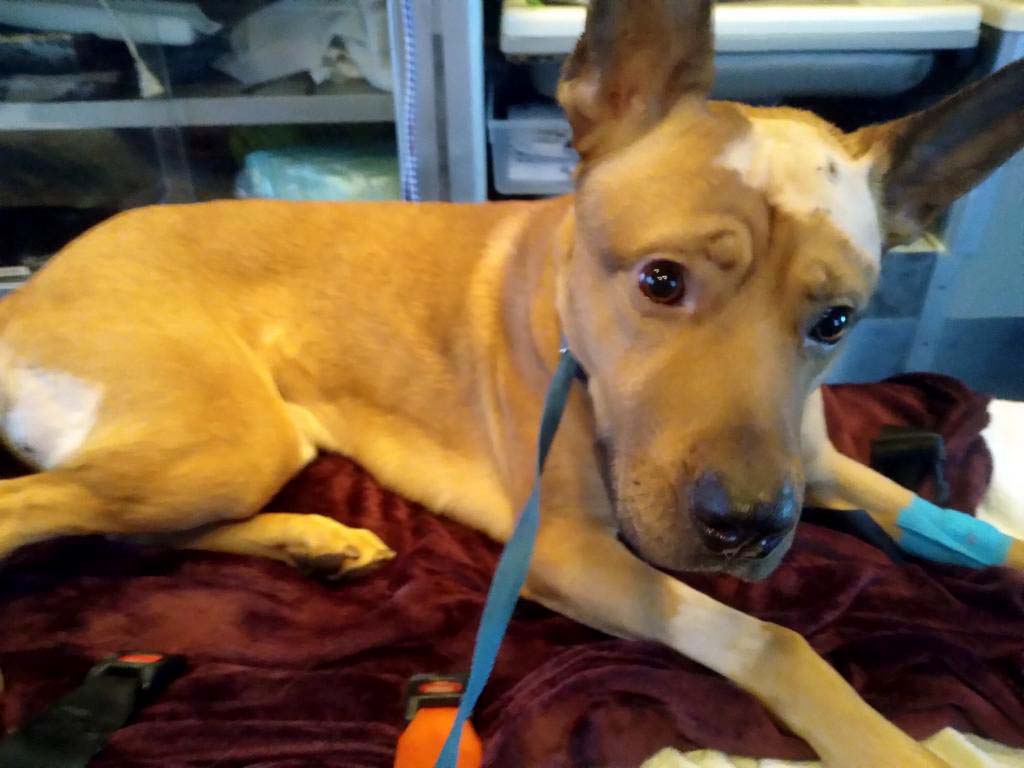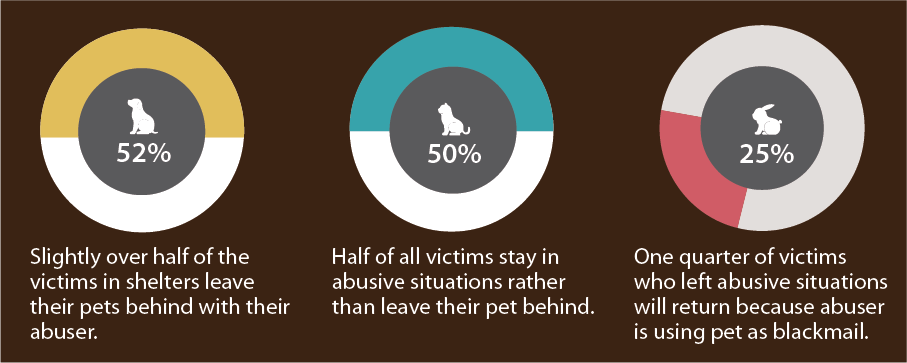The Correlation Between Domestic Violence and Animal Abuse
This is Clyde. Clyde is a sweet, lovable 3-year-old Shepard mix. As an emotional support dog, his 21-year-old owner describes him as “her rock”. And, like most pet owners, she (the owner) considers Clyde a true family member and would do anything to protect him.
But despite her best effort, both the owner and Clyde found themselves victims of an horrific act of domestic violence–an attempted murder-suicide perpetrated by the female victim’s male partner. Clyde was shot twice, once in the head and once in the hip. His owner was also shot twice, both times in the face. Both survived. As a matter of fact, as of this writing, they are both expected to make near full recoveries. To describe their survival as a miracle would be a gross understatement. Whether you believe it’s due to pure luck, divine intervention, or inexplicable forces of the universe, there is no doubt that these two victims are extremely fortunate to be alive. And although what happened in the end was miraculous, the fact that it happened at all is not the least bit surprising.
Defining the Terms
To understand the connection, it’s important to first be clear about what we mean by domestic violence and animal abuse.
- Domestic Violence: Often referred to as intimate partner violence (IPV), domestic violence is a pattern of coercive behaviors used by one person to maintain power and control over another in an intimate relationship. It can include physical violence, sexual abuse, emotional and psychological abuse, financial control, and stalking. It is not a single argument, but a persistent cycle of behavior that instills fear.
- Animal Abuse: Animal cruelty or abuse involves intentionally or negligently causing harm, suffering, or death to an animal. This can range from overt acts of violence, like hitting or kicking an animal, to neglect, such as failing to provide adequate food, water, shelter, or veterinary care.
Both forms of abuse are rooted in a desire for power and control, and both leave lasting scars on their victims.
The Documented Link
The connection between animal abuse and domestic violence is not just anecdotal; it is backed by decades of research. Law enforcement, social workers, and veterinarians have long observed this link in their daily work, and studies have confirmed their observations with compelling data.
- According to the National Coalition Against Domestic Violence, 71% of pet owners entering domestic violence shelters report that their abuser also threatened, injured, or killed family pets. This staggering statistic highlights how abusers often use pets as tools to control and terrorize their human victims.
- Another study found that abusers who also harm pets are more likely to inflict more severe physical and psychological abuse on their human partners and are more likely to engage in child abuse.
- For many victims, concern for their pets’ safety is a significant barrier to leaving an abusive situation. Up to 50% of domestic violence victims report delaying their decision to leave out of fear for their pets’ safety. Because many shelters do not accommodate animals, victims are often forced to make an impossible choice: stay in a dangerous environment or leave their beloved pets behind.
This evidence makes it clear that where there is animal abuse, there is often domestic violence, and vice versa. They are two sides of the same coin of violence.
Why Does This Connection Exist?
Understanding the “why” behind this link is key to breaking the cycle of violence. Several factors contribute to the co-occurrence of domestic violence and animal abuse.
- Power and Control: At its core, domestic violence is about exerting power and control. Abusers often target pets to demonstrate their power and to instill fear. By harming a pet, an abuser sends a clear message to their partner: “If I can do this to the dog, imagine what I can do to you or the children.” It is a chillingly effective way to control and manipulate victims.
- A Tool for Coercion: Pets are often used to force compliance. An abuser might threaten to harm a pet if the victim doesn’t obey their commands, or if they talk about leaving. This creates an environment of constant terror where the victim feels trapped.
- Learned Behavior: Violence is often a learned behavior. Children who witness animal abuse or domestic violence are more likely to become abusers themselves as adults. The “cycle of violence” shows that exposure to abuse normalizes it, perpetuating it from one generation to the next.
- Vulnerability of Victims: Both human victims of domestic violence and animals are in positions of vulnerability. They are dependent on the abuser for care and safety, making them easy targets. The abuser exploits this dependency to maintain control.
The Impact on All Victims
The co-occurrence of these two forms of abuse has a devastating impact on everyone involved.
For human victims, witnessing a beloved pet being harmed can be profoundly traumatizing, often causing feelings of guilt, helplessness, and profound grief. It adds another layer of emotional and psychological torment to an already abusive situation. The fear for a pet’s life can be paralyzing, making it even harder to seek help.
For animals, the consequences are obvious: physical injury, suffering, and sometimes death. But the psychological trauma is also significant. Animals in abusive homes often live in a state of constant fear and stress, which can lead to behavioral problems and long-term health issues. They are not just “collateral damage”; they are sentient beings experiencing terror and pain.
Legal and Social Implications
Recognizing this link has important implications for our legal system and society.
Increasingly, animal cruelty is being treated as a serious crime and a red flag for other forms of violence. In many states, laws now allow judges to include pets in protective orders, giving victims a legal tool to keep their animals safe. Law enforcement officers are being trained to recognize the signs of animal abuse as potential indicators of domestic violence, leading to more comprehensive investigations.
Socially, there is a growing need for greater collaboration between animal welfare organizations, domestic violence shelters, and law enforcement. Programs that provide temporary, safe shelter for the pets of domestic violence victims—often called “pet-friendly” or “safe haven” programs—are critical. These programs remove a major barrier for victims seeking safety, allowing them to leave an abusive home without leaving their pets behind.
What You Can Do: Prevention and Intervention
Everyone has a role to play in breaking the cycle of violence. Here are some ways you can help:
- Be Aware: Learn to recognize the signs of both animal abuse and domestic violence. If you suspect an animal is being abused, report it to your local animal control or humane society. Your report could be the first step in uncovering a wider pattern of abuse.
- Support Local Shelters: Donate to or volunteer with domestic violence shelters and animal rescues, especially those that have programs to house pets.
- Advocate for Stronger Laws: Support legislation that strengthens animal cruelty laws and recognizes the link between animal abuse and domestic violence.
- Spread the Word: Talk to friends, family, and colleagues about this issue. The more people who understand the link, the more likely we are to create a community that protects all its members.
- If You See Something, Say Something: Reporting suspicions can be difficult, but it can save lives—both human and animal. Your intervention could be the lifeline a family needs.
Protecting Every Member of the Family
The connection between animal abuse and domestic violence is undeniable. Recognizing that pets are often victims in abusive households is a crucial step toward creating safer communities for everyone. When we protect animals, we are often also protecting people.
At Squad FiftyOne, we believe that pets are family. Our mission is to provide compassionate care when it matters most, and that includes supporting pet owners in their most difficult moments. If you or someone you know is in a domestic violence situation and is concerned about the safety of a pet, please reach out for help. There are resources available. Let’s work together to ensure that every member of the family—two-legged and four-legged—can live a life free from fear and violence.
If you find yourself and/or your pet victims of domestic abuse there is help available. For help or further information, please contact the following:
American Humane Association – 330.792.9900
National Domestic Violence Hotline: 1.800.799.SAFE (7233)
National Child Abuse Hotline: 1.800.4-A-CHILD (800.422.4453)
National Sexual Assult Hotline: 1.800.656.HOPE (4673)
Red Rover Organization 916.429.2457, www.redrover.org
1. National Coalition Against Domestic Violence, (https://www.thehotline.org) and American Society for the Prevention of Cruelty to Animals (ASPCA)
2. 2021-2022APPA National Pet Owners Survey, (https://www.americanpetproducts.org/pubs_survey.asp)
3. Roguski, Michael, Pets as Pawns: The Co-existence of Animal Cruelty and Family Violence and Carlisle-Frank, Frand & Nielsen (2004): Selective Battering of Family Pet
4.National Coalition Against Domestic Violence, (https://www.thehotline.org)
5.American Society for the Prevention of Cruelty to Animals (ASPCA)


